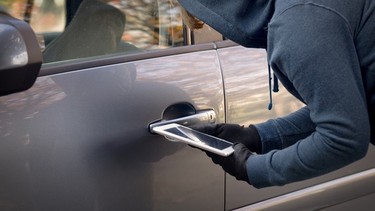
Article content Before you hit the showroom, whether it’s for new or used, you need to know that insurance companies are still reeling from the record theft rates in Canada (we’re in the top ten of the world!), and that new ride you’ve set your heart on may be coming with a hefty surcharge if you don’t purchase an aftermarket antitheft device or system. The surcharges started in earnest in the summer, but more and more vehicles are falling under the surcharge umbrella. Consider the listing from Economical/Definity: a few months ago, their high theft target vehicle (HTTV) list consisted of Dodge RAM 1500 , Jeep Wrangler and Toyota Highlander, model years 2021 and newer.
Today, they will require and pay for the installation of a TAG system on those vehicles to avoid a $1,500 policy surcharge (which has tripled from the $500 it was a few months ago), but have extended their HHTV designation (some business is eligible for a free system; others are discounted) to include newer years of Acura ILX, RDX and TLX; BMW 4-Series and X7-Series; Cadillac Escalade; Chev Suburban; Dodge Charger , Durango, RAM 1500 , and RAM 3500 ; Ford F350; GMC Yukon; Honda CR-V; Jaguar F-Pace; Jeep Gladiator, Grand Cherokee, and Wrangler; Land Rover Defender; Lexus GX, LX, and RX; Maserati Levante; Mercedes G-Class, GL and S-Class; Range Rover, Evoque, and Sport; Toyota 4Runner, Highlander, and Tundra. That’s a big change of hardware in a few short months. Look for it to grow over the coming year.
Aviva has bumped the surcharge on its identified-HTTVs from $500 to $1,000, and while it won’t pay for the installation of a KYCS or TAG system (about $300-$500), installing one will get you a 20% reduction on your comp coverage. New wording from Aviva is if your vehicle is on its list (check with your broker ahead of time), without either a KYCS or TAG system, you do not qualify for OPCF 43 – waiver of depreciation. If your vehicle is gone, you’ll only get the market value determined by the insurance company.
Should you switch insurance companies? Broker Debbie Arnold has some words of caution: “Consumers should not flip out when they get their renewal. Not every carrier surcharges the same vehicles. For example, Wawanesa surcharges the Honda Accord, but Pembridge does not.
Before changing insurers over a theft surcharge, ask the broker if the carrier you’re moving to is caught up on claims. Carriers are still feeling the squeeze of the great resignation from Covid and many claims departments are understaffed. The average caseload for adjusters is 190 claims each.
This is unsustainable.” Nobody is ever going to feel sorry for an insurance company, but it’s good to know you’re moving for the right reason and understand that changes are being made weekly. Insurers are relying on statistics from law enforcement, and many of their highlighted vehicles are featured on things like Equite’s Most Stolen Vehicles lists.
Elliott Silverstein, director of government relations with CAA has a word of caution, however. “Don’t think that because your vehicle isn’t currently on a ‘most stolen’ list means it’s safe. Things can change quickly.
” Recent headlines about a decrease in auto theft in parts of Canada, including Ontario, also pointed out a rise in different regions and targeting different cars as thieves widened their nets. CTV last week reported how easy it is to buy and use an Amazon-sourced device that clones keyfobs. After a car theft summit back in February, the federal government did restrict the “sale, distribution, and importation of radio devices used for auto theft”, but like most things technological, the horses are well clear of the doors.
The key programmer CTV bought and tested is the device “that can be seen on some surveillance videos, with thieves huddled over their tablet screens, usually with a cable plugged into the car’s computer.” The problem for law enforcement? “They can also be used legitimately by car owners looking to get new keys or find faults with their vehicles.” They’re also tools used by legitimate locksmiths.
No matter how much you try to outlaw devices that are readily available to consumers, you can’t track how they will ultimately be used. It’s a desperate game of Whack-a-Mole, and thieves know it. “Law enforcement is at capacity,” says Silverstein.
“We need federal legislation that reflects the current standards of security. It’s got to be an ongoing thing; it’s not one-and-done.” With legislation in place, he would then expect manufacturers to step up and make their vehicles harder to steal, and to be required to update those systems as the technology evolves.
“The current standards were set in place when everyone had a Palm Pilot or a Blackberry in their hand,” he explains with a laugh. “I need to two-factor authentication to get a pizza, but not to take a car?” He believes consumers are more than familiar with and willing to adapt to better measures to protect what is often their second-largest possession. “We use two-factor for banking, for the CRA, for nearly every website.
This is not foreign to the general public.” CAA is the one insurer who has taken a different approach to combat theft. Instead of requiring tracking devices to waive surcharges, they focus on prevention.
Immobilizers, kill switches, and various locking systems – including the familiar Club – will all whittle down that surcharge. Silverstein wants the vehicle to not be stolen in the first place and considers tracking systems to be an additional pressure on law enforcement that could be prevented if the vehicle couldn’t be stolen in the first place. The CTV exercise is important because it highlights the ease with which thieves can circumvent lax safeguards.
The February summit proved that a concerted effort has to come from all players to combat auto theft, but also that the manufacturers could be doing far more. CAA is right: making it harder for the car to be taken would combat so many things that are becoming worse in the auto theft arena. More home invasions, like this recent one in Markham, and carjackings mean this is about a lot more than fancy vehicles disappearing to be sold overseas.
As the level of violence increases, it’s hard to keep thinking it’s just about replacement costs. I asked Silverstein about PIN codes: two-factor authentication for vehicles, as discussed in this column earlier this year. “Cars should have the ability to have it turned on.
Consumers can certainly have the option to turn it off, but it should be an option. Manufacturers have to be a partner instead of an obstacle. Every day that passes more and more consumers are affected.
There is fear; having your car stolen can leave you vulnerable and scared.” Car theft is more than a property crime. Nobody is saying consumers don’t have a duty to better protect their property.
Silverstein says two in 10 still don’t lock their cars, and he thinks if you’re lucky enough to have a garage, you should probably be able to put up a shed for all the junk in your garage and tuck your car away. “We shouldn’t be talking about ‘today’ solutions for a long-term problem We’re in the bottom of the third ad there is a lot more to go,” he says. We’re all just trying to get the thieves to take someone else’s car.
But ultimately, none of those cars should be so easy to steal. Sign up for our newsletter Blind-Spot Monitor and follow our social channels on X , Tiktok and LinkedIn to stay up to date on the latest automotive news, reviews, car culture, and vehicle shopping advice..














